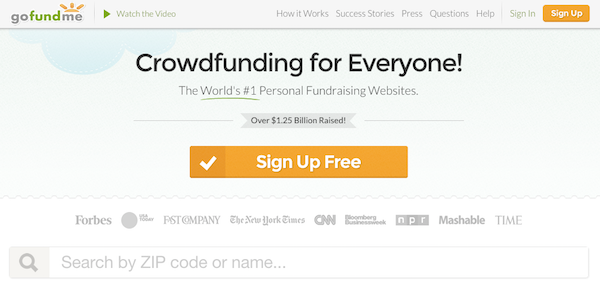1. Kickstarter
Kickstarter is one of the most popular alternatives to Indiegogo. With nearly $2 billion pledged to Kickstarter projects from around the world, this crowdfunding platform is a great choice for creative types or entrepreneurs looking to raise money for a project or product.
The platform takes a 5% fee if your project successfully hits its funding goal and a payment processing fee. You can find the rules (a bit stricter than Indiegogo) that you must adhere to here.
2. RocketHub
Similar to Kickstarter, RocketHub is another way that you can launch a crowdfunding campaign for a project, product, or new venture. Unlike Indiegogo or Kickstarter, RocketHub is a bit of a smaller community and has arguably more focused customer service and education.
If you decide to go with RocketHub, we’ve put together a few places that you can promote your campaign here.
If you reach your fundraising goal, then RocketHub takes a 4% fee and if you fail to reach your goal and want to keep the funds raised, RocketHub takes an 8% fee. This does not include a payment processing fee, which works out to be about 4%.
3. Pozible
Pozible is an Australia-based crowdfunding platform that also caters towards creative types and technology projects.
Unlike Indiegogo, Kickstarter, and RocketHub, Pozible has a bit of a different pricing model. If your project is successful, it will incur the following fees:
- 5%: total funds raised up to $100k
- 4%: total funds raised between $100k – $500k (or projects issued an invitation code)
- 3%: total funds raised of $500k or over.
4. GoFundMe
GoFundMe is the next Indiegogo alternative that I frequently recommend to creators, though the website is far more geared towards personal fundraising campaigns for medical bills, funeral expenses, and education costs.
GoFundMe charges a 5% platform fee, along with payment processing charges which average out to 2-3% of funds raised. In contrast to other crowdfunding websites, GoFundMe allows an ongoing fundraising campaign and does not make you specify how long you’d like to run your online campaign for.
Although GoFundMe has a nice easy-to-use user interface, I’d recommend looking into Indiegogo Life, as it’s cheaper.
5. Prosper
Prosper (or Lending Club) is the fifth substitute to Indiegogo that I recommend to entrepreneurs and creative types.
Prosper is an example of peer to peer lending (learn more) and you can use the website’s marketplace to secure a loan with an interest rate that is lower than a traditional bank loan or credit card. This loan can help capitalize a new venture or pay off existing debt.
If you aren’t familiar, this concept is known as “debt crowdfunding” or the lending subsection of crowdfunding, which is now a billion dollar industry.
6. Seed & Spark
Seed & Spark is a crowdfunding platform for films that serves as both a website to raise money for your upcoming project and distribute it through their ecommerce store.
“Supporters don’t just have to contribute financially – they can also loan or gift the items a filmmaker has listed on their WishList. (Think: Wedding registry for film!)”
Unlike other crowdfunding websites, Seed & Spark only requires that creators hit 80% of their goal before they are “green lighted” and can keep the funds that they’ve raised.
In addition, the website allows donors or backers to cover the 5% platform fee, so that the creators don’t have to.
7. Pubslush
Pubslush is a crowdfunding site for authors, writers, and novelists and serves as a great alternative to Indiegogo. Creators can also create a pre-order campaign for their book.
Pubslush charges a 4% platform fee + payment processing.
They’ve been nice enough to share some advice for authors on my podcast.
8. Self-Hosted Campaign
A self-hosted project refers to when a creator chooses to set up a crowdfunding campaign on their own website, independent of any platform out there.
It’s not terribly difficult to do this with Tilt or by using WordPress to power the site.
There are definitely positives and negatives to launching your own fundraising effort, but if you have the technical chops and marketing savvy, then it’s a good route to go instead of launching on an established platform like Indiegogo.
9. Equity Crowdfunding Platforms
There are a lot of ways to raise capital for a new business. Equity crowdfunding is one of them!
This is just one example of an entrepreneur who raised over $300,000 for his mobile app through this type of crowdfunding.
When you launch a project on an equity crowdfunding website, accredited investors have the chance to invest in your project in exchange for shares in your company.
Before going down this avenue, you should carefully research the different equity crowdfunding sites out there, as each one is different.
10. Set up a Pre-Order Campaign
Finally, rather than launching a project on Indiegogo, you can set up a pre-order campaign on your own website to gather the necessary funds for the initial production run of your product.
There are a few ways that you can do this. I’d set up a WordPress-based website, choose a pre-order plugin (Woocommerce has a good one) or theme that supports pre-orders, and you’re ready to roll!
I highly recommend using Bluehost to host your website if you’re going this route. It’s what this website and all of my other sites use.
Another way to set up a pre-order campaign would be to customize a Shopify store to allow pre-orders or use Celery.











